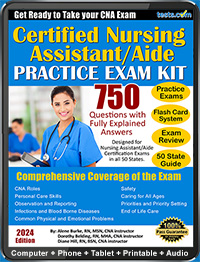Certified Nursing Assistant (CNA) Certification
To get certified as a nursing assistant, you will have to take an exam.
A CNA exam typically has two parts, a written part and a skills part. The written part of the test is typically in a multiple choice format and evaluates your knowledge of the subjects that CNAs are expected to know. Subjects that will be included in the test are: CNA Roles, Observation, Reporting and Abbreviations, Safety and Managing Behavior, Emergencies, Personal Care Skills, Infection Control and Blood Borne Pathogens, Caring for All Ages, Common Physical and Emotional Problems, Care of the Dying Person at the End of Life and Legal and Ethical Issues. All of these topics, or subjects, were covered in your CNA training program. The test will typically have 50 to 70 multiple choice questions, like the ones you will see in our CNA Practice Test.
Dorothy Belding, RN, MSH
Diane Hill, RN, BSN
National Nurse Aide Assessment Program (NNAAP) Exam Content Outline Review
I. Physical Care Skills
A. Daily Living Activities:
- Hygiene
- Dressing and Grooming
- Nutrition and Hydration
- Elimination
- Rest/Sleep/Comfort
B. Skills of Basic Nursing:
- Infection Control
- Safety/Emergency
- Therapeutic/Technical Procedures
- Data Collection and Reporting
C. Restorative Skills:
- Prevention
- Self Care/Independence
II. Psychosocial Care Skills
A. Emotional and Mental Health Needs
B. Spiritual and Cultural Needs
III. Nurse Aide Roles
A. Communication
B. Client Rights
C. Legal and Ethical Behavior
D. Member of the Health Care Team




